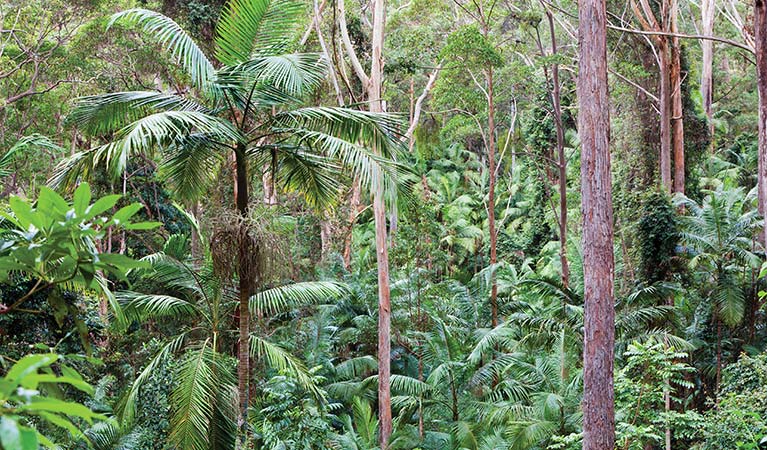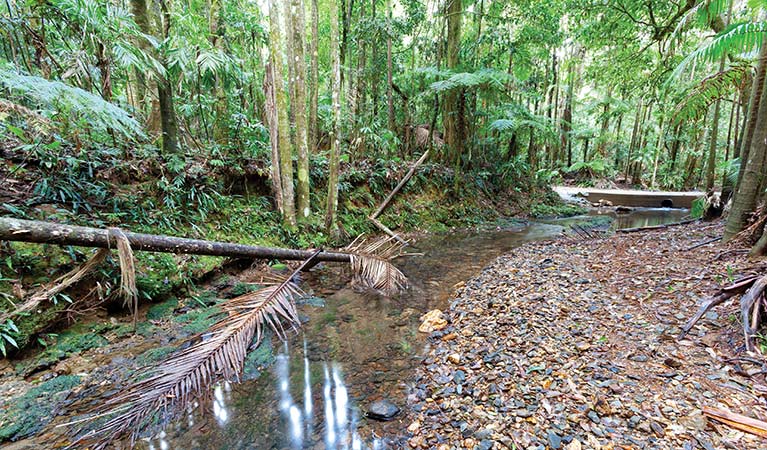Ulidarra walking track
Ulidarra National Park
Overview
Ulidarra walking track is a peaceful walk through the sub-tropical rainforest of Ulidarra National Park. 11km from Coffs Harbour and offering stunning views, it’s perfect for a day trip.
- Where
- Ulidarra National Park in North Coast
- Accessibility
- No wheelchair access
- Distance
- 5km of trails
- Time suggested
- 3 - 5hrs
- Grade
- Grade 5
- What to
bring - Drinking water, hat, raincoat, sturdy shoes, suitable clothing, first aid kit, personal locator beacon, sunscreen, snacks
- Please note
This network of trails has some short and very steep hills on rocky surfaces. It requires a moderate level of fitness.
A short drive from Coffs Harbour, Ulidarra walking track is ideal if you’re looking for a quick nature escape. Winding through unspoilt forest, you can enjoy a feeling of isolation and tranquillity. And along the way you’ll also find scenic views over Coffs Harbour.
Starting from Sealy lookout in Orara East State Forest, you’ll follow the track into Ulidarra National Park and then reach a fork in the path. If you head right, you’ll tackle Ulidarra walking track anti-clockwise as it circles End Peak, the highest point in the park. If you head left you can walk the same track clockwise, or choose a shorter option, following a side-track as it loops around Peak Base walking track before heading back the way you came.
As you walk, you’ll notice the striking shift in vegetation. Below the walking track the area is covered by sub-tropical rainforest. While above the track, tall eucalypt forest dominates the environment.
Also see
-

End Peak walking track
End Peak walking track is a challenging walk that offers rewarding panoramic views of Coffs Harbour from Ulidarra National Park’s highest point. It’s great for birdwatching and for a picnic with a view.
Map

Map legend

Local alerts
For the latest updates on fires, closures and other alerts in this area, see https://www.nationalparks.nsw.gov.au/things-to-do/walking-tracks/ulidarra-walking-track/local-alerts
General enquiries
- National Parks Contact Centre
- 7am to 7pm daily
- 1300 072 757 (13000 PARKS) for the cost of a local call within Australia excluding mobiles
- parks.info@environment.nsw.gov.au
Park info
- in Ulidarra National Park in the North Coast region
Ulidarra National Park is always open but may have to close at times due to poor weather or fire danger.
Visitor info
All the practical information you need to know about Ulidarra walking track.
Track grading
Features of this track
Distance
5km of trails
Time
3 - 5hrs
Quality of markings
Sign posted
Experience required
Some bushwalking experience recommended
Gradient
Very steep and difficult
Steps
Occasional steps
Quality of path
Rough track, many obstacles
Getting there and parking
Ulidarra walking track starts at Sealy lookout in Orara East State Forest. To get there from Coffs Harbour:
- Travel north on the Pacific Highway for around 5km.
- Turn left onto Bruxner Park Road and wind your way up the escarpment past the banana farms.
- Turn left at Sealy Lookout Drive and continue to Sealy lookout.
- The walk starts to the west of the picnic area.
If you have access to 2 vehicles and wish to walk just one-way, you can leave one car at Sealy Lookout and the other car on the corner of Shelter Trail and Swans Road within the park. To get to Shelter Trail and Swans Road from Coffs Harbour:
- Travel north on the Pacific Highway for around 5km.
- Turn left onto Bruxner Park Road and wind your way up the escarpment past the banana farms.
- Turn left at Swans Road and continue 3km to where it meets Shelter Trail.
Road quality
- The road to Sealy Lookout is sealed.
- The roads to the corner of Shelter Trail and Swans Road are unsealed.
- Mixture of sealed and unsealed roads
Vehicle access
- 2WD vehicles
Weather restrictions
- 4WD required in wet weather
Parking
Parking is available at Sealy lookout in Orara East State Forest, including several designated accessible spots.
Facilities
Facilities are located at the start of the walk, at Sealy lookout.
Toilets
- Non-flush toilets
Cafe/kiosk
Maps and downloads
Accessibility
Disability access level - no wheelchair access
Prohibited
Cycling
Fishing
Gathering firewood
Generators
Horses
Pets
Pets and domestic animals (other than certified assistance animals) are not permitted. Find out which regional parks allow dog walking and see the pets in parks policy for more information.
Smoking
NSW national parks are no smoking areas.
Learn more
Ulidarra walking track is in Ulidarra National Park. Here are just some of the reasons why this park is special:
Land of Gumbaynggir

As you explore the remote bushland and admire the unspoilt beauty of Ulidarra National Park, you'll be walking on the traditional lands of the Gumbaynggirr People. The park is part of a larger 'men's area' and was once used for hunting and gathering of bush foods and medicines. The area continues to have special significance for Gumbaynggirr people as it connects them with their Dreamtime stories.
- Ulidarra walking track Ulidarra walking track is a peaceful walk through the sub-tropical rainforest of Ulidarra National Park. 11km from Coffs Harbour and offering stunning views, it’s perfect for a day trip.
Mid North Coast menagerie

Along with the adjoining Bruxner Park Flora Reserve, Ulidarra provides important habitats for a diverse range of wildlife, including koalas, masked owls, dingoes and little bent-wing bats. Some 232 native vertebrate species make this beautiful place their home, including 40 different mammals, reptiles, frogs and fish. If you're lucky, you might spot threatened species such as Stephens banded snakes, yellow-bellied gliders and powerful owls. There are also 125 different bird species found in Ulidarra, making it a haven for birdwatching. Amongst the myriad of birds you'll find here, you might catch a glimpse of threatened species such as glossy black-cockatoos, brown tree-creepers, barred cuckoo-shrikes, black bitterns, barking owls, powerful owls, wompoo fruit-doves and rose-crowned fruit-doves.
- End Peak walking track End Peak walking track is a challenging walk that offers rewarding panoramic views of Coffs Harbour from Ulidarra National Park’s highest point. It’s great for birdwatching and for a picnic with a view.
- Ulidarra walking track Ulidarra walking track is a peaceful walk through the sub-tropical rainforest of Ulidarra National Park. 11km from Coffs Harbour and offering stunning views, it’s perfect for a day trip.
Park of the people

From the early 1880s, Ulidarra National Park and the adjoining Bruxner Park Flora Reserve were used for logging. Throughout the park, you might come across tree stumps that bear the scars of board cuts, a style of tree felling that took place up until the early 1950s. Starting in the early 1930s, local community lobbying for the protection of these areas has seen the protection of Bruxner in 1933, the establishment of Bruxner Park Flora Reserve in 1958, and later the establishment of Ulidarra and nearby Bindarri National Park in 1999.
Precious plant life

Ulidarra National Park provides an important link between the hinterland and plateau habitats of the World Heritage-listed Dorrigo National Park, connecting the mountain ranges of Tuckers Nob in Bindarri National Park to the coastal habitats of Moonee Beach Nature Reserve and Coffs Coast Regional Park. The park conserves rare lowland rainforest, with species such as red carabeen, booyong and bangalow palms. You'll also find old growth sclerophyll forest with coastal blackbutt and turpentine trees, and small areas of wet sclerophyll forest dominated by brushbox.
- End Peak walking track End Peak walking track is a challenging walk that offers rewarding panoramic views of Coffs Harbour from Ulidarra National Park’s highest point. It’s great for birdwatching and for a picnic with a view.
Plants and animals protected in this park
Animals
-

Koala (Phascolarctos cinereus)
One of the most renowned Australian animals, the tree-dwelling marsupial koala can be found in gum tree forests and woodlands across eastern NSW, Victoria and Queensland, as well as in isolated regions in South Australia. With a vice-like grip, this perhaps most iconic but endangered Australian animal lives in tall eucalypts within a home range of several hectares.
-

Grey-headed flying-fox (Pteropus poliocephalus)
The grey-headed flying fox is Australia's largest native bat, with a wingspan up to 1m. This threatened species travels up and down south-eastern Australia and plays a vital role in pollinating plants and spreading seeds in our native forests.
-

Eastern bentwing-bat (Miniopterus schreibersii oceanensis)
Eastern bentwing-bats congregate in caves across the east and north-west coasts of Australia, in colonies of up to 150,000. These small Australian animals weigh around 13-17g and can reach speeds of up to 50km per hour. Eastern bentwing-bats use both sight and echolocation to catch small insects mid-air.

